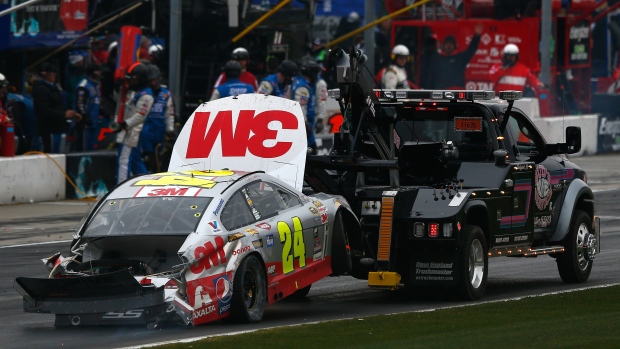Mar 6, 2015
Gordon to meet with NASCAR to discuss safety
Jeff Gordon, upset after a hard hit into a concrete wall at Atlanta, will meet with NASCAR next week to discuss safety initiatives. Gordon hit a section of wall on Sunday that was not protected by an energy-absorbing SAFER barrier.
The Canadian Press

LAS VEGAS, Nev. - Jeff Gordon, upset after a hard hit into a concrete wall at Atlanta, said Friday he'll meet with NASCAR next week to discuss safety initiatives.
Gordon hit a section of wall on Sunday that was not protected by an energy-absorbing SAFER barrier. The four-time NASCAR champion has hit numerous unprotected walls since SAFER barriers were first installed at tracks in 2002.
NASCAR said Gordon will meet Tuesday with executive vice-president Steve O'Donnell, and Gordon said he'd like a timetable on additional soft walls being added to tracks.
"The one thing I would question was when did SAFER barriers start being put at racetracks, and what was the plan for them to be complete, and where are we in that plan?" Gordon said. "I was under the impression when they started going in, it was going to be three- or four-year plan to complete the SAFER barriers on every wall that needed a SAFER barrier."
SAFER barriers were one of the many safety initiatives that came about after Dale Earnhardt's death in 2001 in an accident on the last lap of the Daytona 500.
The soft walls were developed by Dr. Dean Sicking at the University of Nebraska, and although they debuted in 2002 at Indianapolis Motor Speedway, they were gradually added to tracks the next year and are currently installed in some form at every track used by NASCAR's top series.
The barriers, a combination of steel and foam, cost about $500 a foot. But, the cost has proven worth it as the walls absorb the energy during impact and have repeatedly lessened injuries sustained to a driver.
The barriers are installed and placed where NASCAR recommends.
There's been increased scrutiny on the absence of SAFER barriers since Kyle Busch broke his right leg and left foot at Daytona last month. Tracks have been reviewing their safety standards since Busch's wreck and Las Vegas Motor Speedway made some slight modifications to two different portions of the track before Sunday's race.
Atlanta last week added 130 linear feet of protective barrier to extend coverage of the protective wall at the exit of pit road near Turn 1. The track also put up a tire barrier along the inside wall of Turn 4. Phoenix is making modifications before next week's race.
Gordon, who in 2008 had a hard hit into an unprotected wall at Las Vegas that led track officials to install a SAFER barrier in that spot after the race, understands there's not an immediate solution.
"I don't think anybody expected them to have SAFER barriers around every wall, day one," Gordon said. "I think I'm realistic to know that we just can't have them next week. It takes a while to manufacture them. My question is what is the timeframe to have those built and installed. I think everybody knows it's a priority.
"It seems to be pushed further along since Kyle's accident. Where were we prior to Kyle's accident?"
Gordon, who has said this will be his final year in full-time racing, said there's an incredible difference in impact when a driver hits an unprotected wall.
"What always comes to mind to me, when I hit a non-SAFER barrier wall, I go, 'Wow what did I just hit?' " Gordon said. "I'm always caught off guard by the impact and how severe it is.
A SAFER barrier wall, and this happened to me I think at Texas ... I blew a right front tire going into Turn 1, and I was like, 'Oh God, this is going to hurt.' But then it was 'Oh, that wasn't so bad.'
"It's a huge difference."
